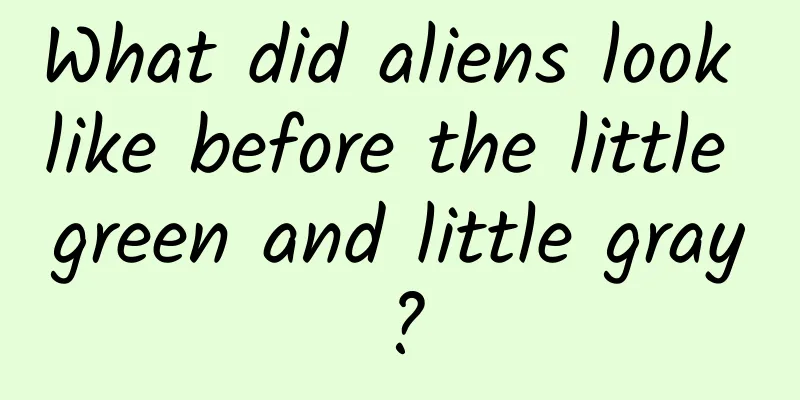What did aliens look like before the little green and little gray?

|
© Emmanuel Lafont Leviathan Press: The etymology of the word "Alien" can be traced back to the Latin word "alienus" more than a thousand years ago, which means "belonging to someone else" or "foreign", and is derived from "alius" (other). It was only in later evolution that the word began to refer specifically to "people". In English, "alien" can be used to describe foreigners, aliens, or people who do not belong to a specific group or place. The Chinese translation of "alien" is more direct, and it is difficult for people not to assume that aliens look like us. In October 1961, Betty and Barney Hill were chatting with an astronomy lecturer at their New Hampshire home and made a rather bizarre claim.[1] The couple (a social worker and a postal clerk) claimed to have been abducted by aliens while driving through New Hampshire’s White Mountains a month earlier.[2] The Hills explained that they then underwent a series of invasive “examinations” aboard a UFO-style spacecraft. The story captured the public's imagination and is widely credited with launching the entire alien abduction genre - it was the first such story to be published and spawned scores of other stories from ordinary people recounting similar experiences. It also led to another revolution in Hollywood movies. In the Hills' account, the alien creatures they encountered had oversized heads, huge brains, big eyes, gray skin, small noses and slit mouths. The couple actually created the typical image of science fiction movie aliens - like weird, twisted human babies. © The Christian Science Monitor Along with several similar stories that appeared at the same time, television shows and movies quickly adopted the image of the big-headed alien creatures. According to science writer Wade Roush, " The standard image of aliens became the little grey men. " Thus, when Steven Spielberg made two influential alien movies, Close Encounters of the Third Kind (1977) and E.T. the Extraterrestrial (1982), the aliens in both movies were essentially the same image of the little green or grey men of the 1950s and 1960s. So how were aliens depicted before they formed in the public imagination, and what influenced our perceptions of them? Many generations ago, the aliens in early science fiction were more fantastical and bizarre - including creepy octopus creatures, intelligent insect creatures and huge reptiles. A refreshing example The geometric creatures in the 1888 science fiction novel "The Sipehus" have a complex language and even a complete cultural system. © Emmanuel Lafont In 1887 – before there were words like “sliced bread,” “popsicles” or even “teenagers” – science fiction writer Joseph Henri Honoré Boex conceived Les Xipéhuz in his Brussels office. The book is set on Earth, a thousand years before the ancient Mesopotamian cities of Nineveh and Babylon were founded. The story begins in a dreamlike scene: in a forest clearing, a nomadic tribe is looking for a place to rest for the night, but they accidentally discover "Les Xipéhuz", which means "Geometric Shapes". These odd, geometric creatures are described as "blue, transparent cones" with their tips pointed upward. Each creature is about half the size of a human, with striped markings and "a star near the base that shines as brightly as the midday sun." © Scott Nicolay These creatures are considered to be some of the earliest non-human aliens in science fiction, providing a cautionary tale of the devastation that can result from first contact between humans and an unfamiliar “other.”[3] After many battles, it was ultimately determined that diplomacy had no chance of success. Even the way these shapes communicate with each other - by using the light from the stars to trace symbols on each other's bodies - seems extraordinary. But in the end, they were wiped out. In fact, the timing of this story is not accidental. Boring start Thark, a green alien with six limbs and a reptilian appearance, from A Princess of Mars (1912). © Emmanuel Lafont For thousands of years, humans have pondered the possibility of life on other planets. Around 450 B.C., the ancient Greek philosopher Anaxagoras, after a career-long intensive observation of the heavens, proposed a tentative idea: the Moon might not be a god, as was commonly believed, but a rock like Earth. In fact, he thought, the Moon might even harbor life. Anaxagoras was promptly sentenced to death for impiety—but the idea that there were other celestial bodies like Earth persisted. Decades later, philosopher Democritus came to a similar conclusion, speculating that matter in the universe might be made up of tiny particles called atoms. “ That led to the idea that if there were an infinite number of atoms, then maybe there were an infinite number of other planets,” says Roush. © Emmanuel Lafont But despite the long history of such speculation, these early ideas about aliens were not like the imaginative creations we see in books and on television today. " When people think about aliens, I'm afraid they basically assume that if there are aliens out there, they're going to look like us," Roush said. "So intelligent, sentient beings are basically going to be humanoid. " After all, what else could one expect at that time? No one, Rausch explains, had really thought about our origins or how we related to other species— so there wasn’t much room to imagine the existence of rational beings outside of our own image. “You can even see this in religious symbols and mythology,” Rausch added. From the ancient Egyptian goddess Hathor to the Roman goddess Minerva, most religious entities have some human characteristics. But everything changed in 1859, when a book with an emerald green cover and gold lettering first appeared on the shelves of intellectuals around the world. It was Charles Darwin’s On the Origin of Species, which would have as much impact on science fiction as it did on biology. "I think since then, our imaginations of what aliens might look like have become much broader," Roush said. Magical Creatures Garden The Star Maker (1937), the eponymous protagonist, is a sentient, godlike star who creates the universe. © Emmanuel Lafont First up are the geometric creatures in The Sipehus. But soon all sorts of strange life forms appeared, rivaling those on Earth. By the time The War of the Worlds was published in 1898, aliens had become extremely bizarre and terrifying. In this novel, H.G. Wells introduced readers to the Martians - consisting of a huge, disembodied head with a beak-like mouth surrounded by tentacles. They reproduced asexually and fed on fresh human blood, sucking blood into their bodies using straws. Wells's Martian (1917) by French illustrator M. Dudouyt. © Le chien critique “They’re part insect, part octopus, part crab. So starting in the 19th century, people start seeing some very creepy, non-human aliens because people are finally realizing that evolution is a real phenomenon and that it might take a completely different path in other parts of the universe than it does on our planet, ” Roush said. This breed of sci-fi aliens continued to thrive in literature in the decades that followed, with the insectoid Selenites in First Men in the Moon (1901), the flamingo-like Tweels in A Martian Odyssey (1934), and the dazzling, sentient stars in Star Maker (1937). In The First Men on the Moon (1901), the Selenites are upright quadrupeds with jointed limbs, very similar to insects. © Emmanuel Lafont The rise of Hollywood in the 20th century once again changed our view of aliens, with aliens that looked extremely similar to humans appearing on the screen. "I think the main practical reason is that it's much easier to put an alien costume on a human than to come up with something very evolutionarily remote - it's much easier to dress a human up as an alien and have him walk on two legs and operate with two hands than to come up with an alien creature that's half octopus, half insect," Roush said. Martian creatures from the TV series Quatermass and the Pit (1958). © Asymptote Journal So, inspired by the Hills and others, aliens that walked on two legs and were somewhere between humans and "others" became the standard. "Even in a show like Star Trek, almost all the aliens were humanoid, obviously for budgetary reasons," Roush said. In A Martian Odyssey (1934), the alien creature Tver resembles a shaved flamingo, with its brain in its belly and humans as its friends. © Emmanuel Lafont In recent decades, however, new technologies have changed what’s possible. With increasingly powerful computer image generation and artificial intelligence, things are starting to get weird again. One example is the movie Arrival, in which seven-legged, extraterrestrial beings called Heptapods visit Earth with super-sensory abilities. "Having these amazing appendages that can spray ink to communicate is really different. We can invent 3D monsters and aliens that may never physically exist," says Roush. Who knows what kind of aliens science fiction will imagine, perhaps even stranger than what we will actually find on other planets in the future... References: [1]www.cia.gov/readingroom/docs/CIA-RDP81R00560R000100010003-8.pdf [2]www.history.com/news/first-alien-abduction-account-barney-betty-hill [3]www.jstor.org/stable/26835581 By Zaria Gorvett Translated by Mi Lai Proofreading/Rabbit's Light Footsteps Original article/www.bbc.com/future/article/20231019-the-weird-aliens-of-early-science-fiction This article is based on the Creative Commons License (BY-NC) and is published by Mi Lai on Leviathan The article only reflects the author's views and does not necessarily represent the position of Leviathan |
<<: Deadly and fatal! Is the "beautiful killer" in the ocean also an excellent doctor?
Recommend
Beijing is hit by sandstorms! How severe is it? How can we protect ourselves?
The Central Meteorological Observatory issued a y...
What are the costs for developing a mall mini program?
1. Free store opening with mini programs: Most ma...
Do companies still need to do marketing during the epidemic? What to do?
People are in panic due to the epidemic. The skyr...
WeChat Reading: 5 APP fission growth methods based on paid membership
WeChat Reading has made good use of its product t...
Officially abandoning the domestic market: LeWa OS will move overseas
March 2 news, I believe many friends have heard o...
KEEP product analysis
During the Spring Festival, Keep Live Class launc...
101 years old! The world's oldest doctor reveals 5 secrets to longevity and anti-aging, which many people fail to follow
Imagine if you go to see a doctor and the doctor ...
Deconstruction and reconstruction behind product operations: Why was P&G's brand empire "dismembered"? Why can Toutiao become a platform?
1. Unbundle I mentioned a point in the article &q...
Does laundry detergent also contain carcinogens? Take a quick look at the ingredient list of the one you are using...
Laundry detergent is a detergent that is often us...
Visibility is too low, can't see the runway clearly? There is a "secret trick" for the plane to land
On a calm night, a gentle breeze blew quietly ove...
Siberian tigers are on the scene! The "king of the jungle" is not just a saying
Review expert: Wang Lei, National Park and Nature...
Does breathing affect vision? Scientists discover mysterious rules of pupils →
Compiled by: Gong Zixin Like the aperture of a ca...
Winter health guide for diabetics
As the weather turns cold, the cold winter is com...
Research on audio and video playback technology in Android system
Author: Hu Rui, Unit: China Mobile Smart Home Ope...
A brief discussion on how to attract new customers in K12 education
This time, the author started from the entry poin...









